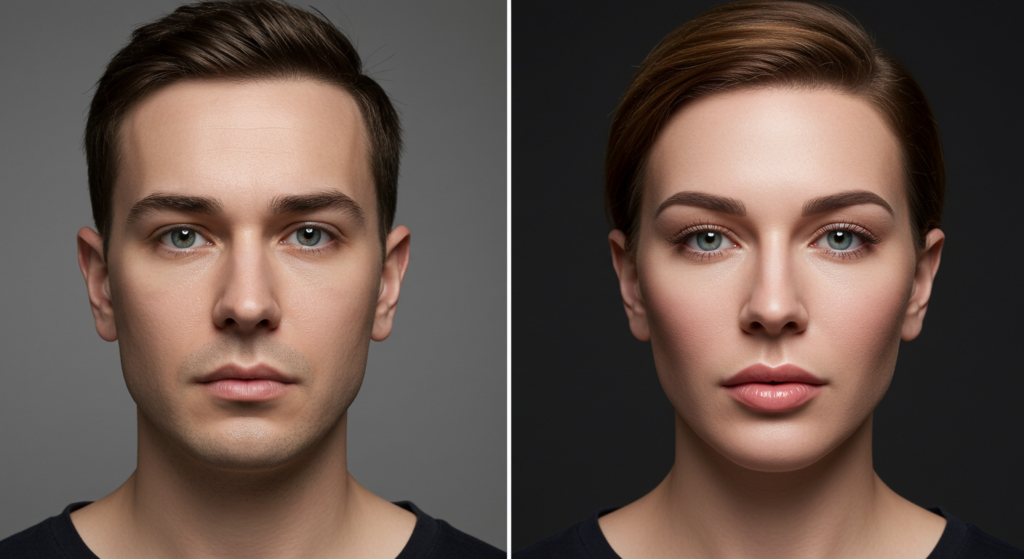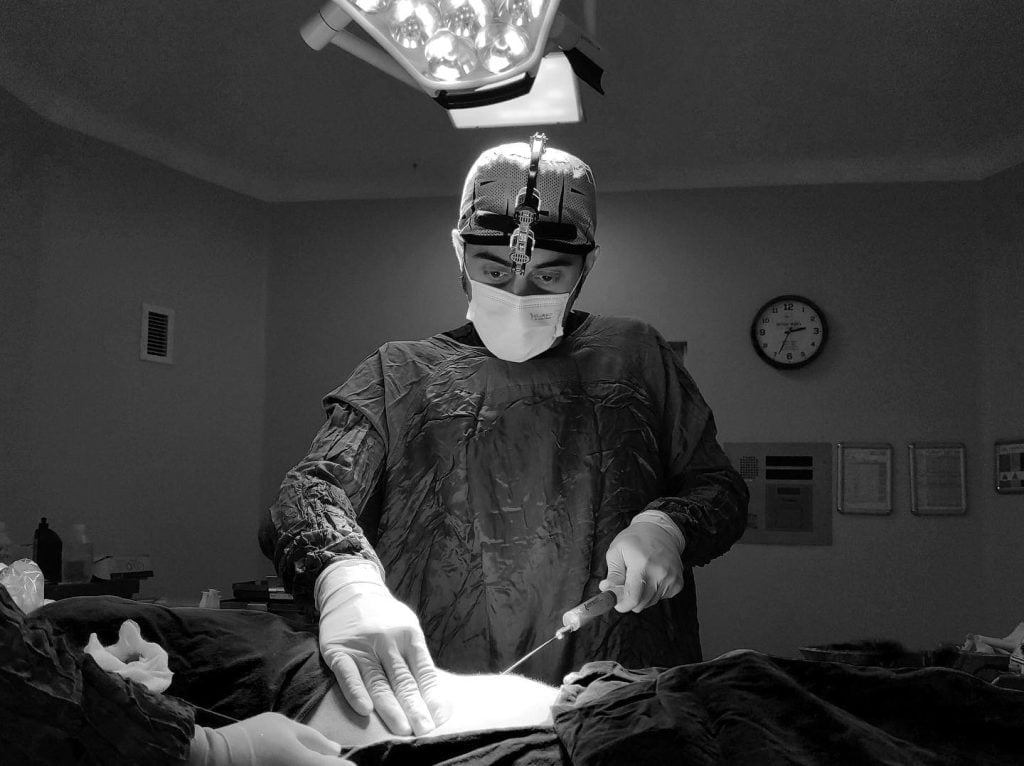For many individuals undergoing a gender transition from male to female (MTF), achieving facial congruence with their gender identity is a deeply personal and significant milestone. The face is often the first aspect of a person observed, and for transgender women, the desire for their facial features to align with their inner sense of self can be incredibly strong. This journey often leads them to explore Facial Feminization Surgery, commonly known as FFS. If you are an MTF trans woman seeking to understand more about FFS and how it can help you achieve a more feminine and attractive face, you’ve come to the right place. This comprehensive guide will delve into the intricacies of FFS, covering everything from what it is and why it’s important, to the various procedures involved, the recovery process, and how to choose the right surgeon.

Table of Contents
Understanding the Importance of Facial Feminization for MTF Trans Women
The desire for an attractive face is not merely about aesthetics; for MTF trans women, it’s often deeply intertwined with their sense of self, their mental well-being, and their ability to navigate the world authentically. Facial features often carry strong gender associations, and incongruence between one’s facial appearance and gender identity can lead to significant distress, known as gender dysphoria. This discomfort can manifest in various ways, including anxiety, depression, social isolation, and a diminished sense of self-worth.
For MTF trans women, FFS can be a transformative step in their transition journey. By addressing masculine facial features and reshaping them to appear more feminine, FFS can help individuals feel more comfortable and confident in their own skin. It can also significantly improve their social interactions, reducing instances of misgendering and increasing their sense of safety and acceptance in public. Ultimately, FFS is about aligning one’s external appearance with their internal identity, contributing to a greater sense of wholeness and well-being, and helping them feel more like their true selves, often leading to the realization of a more attractive face that resonates with their femininity.

What Exactly is Facial Feminization Surgery (FFS)?
Facial Feminization Surgery (FFS) is not a single procedure but rather a collection of surgical techniques designed to soften and feminize the facial features of transgender women. The specific procedures involved in FFS are highly individualized and depend on the unique facial structure of each person, as well as their desired aesthetic goals. The aim of FFS is to reduce or reshape features that are typically associated with masculinity, such as a prominent brow bone, a wider jawline, or a more angular chin, and to enhance features that are traditionally considered feminine, such as fuller cheeks, softer contours, and a more delicate nose. The ultimate goal is to create a harmonious and feminine facial appearance that helps the individual feel more comfortable and confident in their gender identity, often resulting in what they perceive as a more attractive face.
Who is a Good Candidate for FFS?
Determining whether FFS is the right step for you is a personal decision that should be made in consultation with qualified medical and mental health professionals. However, some general characteristics and considerations often apply to individuals who are good candidates for FFS:
- Gender Identity: The primary criterion is a well-established and persistent female gender identity. Individuals typically have been living as women for a significant period and have a strong understanding of their gender identity.
- Emotional Maturity and Stability: Undergoing any surgical procedure, especially one as significant as FFS, requires emotional maturity and stability. Candidates should have realistic expectations about the outcomes of the surgery and be prepared for the emotional and physical recovery process.
- Good Physical Health: Candidates should be in good overall physical health to minimize the risks associated with surgery and anesthesia. Any pre-existing medical conditions should be well-managed.
- Realistic Expectations: It’s crucial to have realistic expectations about what FFS can achieve. While surgery can significantly feminize the face, it may not result in a perfect or idealized image. The goal is to achieve a more feminine and harmonious appearance that aligns with the individual’s gender identity and enhances their sense of self, contributing to a more attractive face in their own eyes.
- Understanding the Risks and Benefits: Candidates should have a thorough understanding of the potential risks, benefits, and limitations of the specific FFS procedures they are considering. This involves open and honest communication with their surgeon.
- Desire for Facial Congruence: The primary motivation for seeking FFS is typically a desire to alleviate gender dysphoria related to facial features and to achieve greater congruence between their appearance and their gender identity. Many seek FFS to feel more comfortable and confident in their daily lives and to be perceived by others as the women they are, often contributing to their personal definition of an attractive face.
- Support System: Having a strong support system of friends, family, or a therapist can be beneficial throughout the FFS journey, from the initial decision-making process to the recovery period.

Common Facial Feminization Surgery Procedures Explained
FFS encompasses a wide range of surgical procedures, and the specific combination of procedures will vary depending on the individual’s facial structure and goals. Here are some of the most common FFS procedures:
Forehead Contouring (Brow Bone Reduction and Forehead Shaping)
The forehead and brow bone are often key areas that contribute to a masculine appearance. Forehead contouring aims to create a smoother, more rounded, and feminine forehead. This typically involves two main techniques:
- Brow Bone Reduction: In individuals with a prominent brow bone, the surgeon can shave down or reshape the bone to create a flatter and more feminine contour. The approach used depends on the severity of the protrusion and may involve an incision in the hairline or within the scalp.
- Forehead Shaping: The shape of the forehead itself can also be addressed. A more feminine forehead tends to be smoother and slightly more vertical. In some cases, bone cement or other materials may be used to fill in depressions or create a more rounded shape. This procedure can significantly soften the upper face and contribute to a more attractive face.
Rhinoplasty (Nose Reshaping)
The nose plays a central role in facial aesthetics, and rhinoplasty can significantly impact the overall femininity of the face. Masculine noses tend to be larger, wider, and have a more prominent bridge, while feminine noses are often smaller, narrower, and more delicate. Rhinoplasty in FFS can involve:
- Reducing the Size of the Nose: This may involve reshaping the nasal bones and cartilage to create a smaller and more refined appearance.
- Narrowing the Nasal Bridge: A wider nasal bridge can be narrowed to create a more feminine profile.
- Refining the Nasal Tip: The shape and projection of the nasal tip can be altered to create a more delicate and upturned appearance.
- Adjusting the Nasolabial Angle: The angle between the nose and the upper lip can be adjusted to create a more feminine profile. A well-executed rhinoplasty can bring balance and harmony to the face, enhancing its overall attractiveness.
Cheek Augmentation
Fuller cheeks are often associated with youthfulness and femininity. Cheek augmentation can enhance the volume and projection of the cheeks, creating a softer and more rounded facial contour. This can be achieved through various methods:
- Fat Grafting: Fat is harvested from another area of the body (such as the abdomen or thighs) and injected into the cheeks to add volume. This is a natural and long-lasting option.
- Dermal Fillers: Injectable fillers made of hyaluronic acid or other biocompatible materials can be used to temporarily augment the cheeks. While not permanent, this is a less invasive option.
- Cheek Implants: Silicone or other biocompatible implants can be surgically placed in the cheek area to provide permanent volume enhancement. Cheek augmentation can create a more youthful and feminine midface, contributing to a more attractive face with softer contours.
Jaw Contouring (Reduction and Shaping)
The jawline is another key feature that often differs between genders. Masculine jawlines tend to be wider and more angular, while feminine jawlines are typically softer, narrower, and more tapered. Jaw contouring in FFS can involve:
- Jaw Reduction: This typically involves surgically shaving down the corners of the jawbone to create a narrower and more oval or heart-shaped facial structure. The incision is usually made inside the mouth, leaving no visible external scars.
- Jawline Shaping: In some cases, the overall shape of the jawline can be refined to create a smoother and more feminine contour. Jaw contouring can dramatically soften the lower face and contribute significantly to a more feminine and attractive face.
Chin Contouring (Reduction or Augmentation)
The chin is a central facial feature that can significantly impact the overall gender presentation. Masculine chins tend to be wider, longer, and more square, while feminine chins are often narrower, shorter, and more rounded or pointed. Chin contouring in FFS can involve:
- Chin Reduction: If the chin is too wide or long, the surgeon can shave down the bone to create a more delicate and feminine shape.
- Chin Augmentation: In some cases, the chin may be too small or recessed. Chin augmentation using implants or fat grafting can create a more balanced and feminine profile.
- Chin Shaping: The overall shape of the chin can be refined to achieve a more rounded or pointed appearance, depending on the individual’s facial structure and desired aesthetic. Chin contouring plays a crucial role in harmonizing the lower face and enhancing its femininity, contributing to an attractive face.
Lip Lift and Augmentation
The lips are a prominent feature of the lower face and can significantly contribute to a feminine appearance. Feminine lips tend to be fuller, more defined, and have a shorter distance between the base of the nose and the upper lip. Lip lift and augmentation procedures can enhance these features:
- Lip Lift: This procedure shortens the distance between the nose and the upper lip, exposing more of the upper teeth when smiling and creating a more youthful and feminine appearance.
- Lip Augmentation: Fuller lips can be achieved through various methods, including fat grafting and dermal fillers. These techniques add volume and definition to the lips, enhancing their attractiveness.
Tracheal Shave (Adam’s Apple Reduction)
The Adam’s apple, or laryngeal prominence, is a visible protrusion in the neck that is often associated with masculinity. A tracheal shave is a relatively minor surgical procedure that involves reducing the size of this cartilage to create a smoother and more feminine neckline. The incision is typically small and placed in a natural skin crease to minimize scarring.
Hairline Lowering
A higher hairline can sometimes be perceived as more masculine. Hairline lowering surgery, also known as forehead reduction, can bring the hairline down to a more feminine position, creating a smaller forehead and improving facial proportions. This can be achieved through surgical advancement of the scalp or through hair transplantation.
Preparing for Your FFS Journey
Once you’ve decided to pursue FFS, thorough preparation is essential for a smooth and successful experience. This typically involves several steps:
- Consultations with Your Surgeon: You will have multiple consultations with your chosen surgeon to discuss your goals, assess your facial structure, and determine the most appropriate procedures for you. This is the time to ask all your questions and ensure you have a clear understanding of the surgical plan, potential risks, and expected outcomes.
- Medical Evaluations: Your surgeon will likely require you to undergo various medical evaluations to ensure you are in good health for surgery. This may include blood tests, an electrocardiogram (ECG), and other tests as needed.
- Psychological Assessment: Many surgeons and healthcare providers require a psychological assessment from a qualified therapist specializing in gender identity. This assessment helps ensure that you have a clear understanding of your gender identity and realistic expectations about the outcomes of FFS.
- Hormone Therapy: It is generally recommended that individuals considering FFS have been on feminizing hormone therapy (HRT) for a significant period (typically at least one year). HRT can cause some feminizing changes to the face, and it’s important to allow these changes to occur before undergoing surgery.
- Lifestyle Adjustments: Your surgeon will provide specific instructions regarding lifestyle adjustments before surgery, such as stopping smoking, avoiding certain medications (like blood thinners), and maintaining a healthy diet.
- Planning for Recovery: It’s crucial to plan for your recovery period. This includes arranging for time off work or school, having someone to assist you with daily tasks, and preparing a comfortable and supportive environment at home.
What to Expect During the FFS Procedure
The FFS procedure is typically performed under general anesthesia, meaning you will be completely asleep during the surgery. The length of the surgery will vary depending on the number and complexity of the procedures being performed, but it can range from several hours to a full day.
The surgeon will make incisions in strategic locations, often within the hairline, inside the mouth, or in natural skin creases, to minimize visible scarring. The specific techniques used will depend on the individual procedures being performed. For example, in forehead contouring, the surgeon may access the brow bone through an incision in the hairline. In jaw reduction, the incisions are typically made inside the mouth.
Once the necessary reshaping and modifications are complete, the incisions will be closed with sutures. You will likely wake up in a recovery room where you will be closely monitored as you recover from anesthesia.
Recovering After Facial Feminization Surgery
The recovery period after FFS is crucial for optimal healing and achieving the best possible results. It’s important to follow your surgeon’s instructions carefully. Here’s what you can generally expect:
- Initial Recovery: In the immediate days and weeks after surgery, you will likely experience swelling, bruising, and discomfort. Pain medication will be prescribed to manage any pain. You may also have drains placed to remove excess fluid.
- Swelling and Bruising: Swelling and bruising are common and can be significant, especially in the first few weeks. Applying cold compresses can help reduce swelling. The majority of the visible swelling and bruising will typically subside within a few weeks, but some subtle swelling may persist for several months.
- Incision Care: You will need to care for your incisions according to your surgeon’s instructions. This may involve keeping them clean and dry and applying antibiotic ointment.
- Dietary Restrictions: You may be on a soft or liquid diet for a period, especially if you have had procedures involving the jaw or mouth.
- Activity Restrictions: You will need to avoid strenuous activities and heavy lifting for several weeks to allow your body to heal properly.
- Follow-Up Appointments: You will have regular follow-up appointments with your surgeon to monitor your healing progress and address any concerns.
- Patience is Key: It’s important to be patient during the recovery process. The final results of FFS may not be fully apparent for several months as the swelling gradually subsides and the tissues settle.
Potential Risks and Complications of FFS
As with any surgical procedure, FFS carries potential risks and complications. While these are relatively rare when performed by a qualified and experienced surgeon, it’s important to be aware of them:
- Infection: Infection at the surgical site is a possibility.
- Bleeding: Excessive bleeding during or after surgery can occur.
- Nerve Damage: There is a risk of temporary or permanent nerve damage, which can affect sensation or muscle movement in the face.
- Poor Wound Healing: Incisions may not heal properly, leading to scarring.
- Asymmetry: While surgeons strive for symmetry, some degree of asymmetry can occur.
- Unsatisfactory Results: In some cases, the aesthetic outcome may not meet the patient’s expectations, potentially requiring revision surgery.
- Anesthesia Risks: There are risks associated with general anesthesia.
- Specific Risks Related to Individual Procedures: Each specific FFS procedure has its own set of potential risks and complications that your surgeon will discuss with you in detail.
Choosing a highly qualified and experienced FFS surgeon is crucial to minimizing these risks and maximizing the chances of a successful outcome.

Choosing the Right FFS Surgeon
Selecting the right surgeon is one of the most important decisions you will make in your FFS journey. Here are some key factors to consider when choosing an FFS surgeon:
- Experience and Specialization: Look for a surgeon who has extensive experience performing FFS specifically for MTF transgender women. Ideally, they should specialize in this area.
- Board Certification: Ensure that the surgeon is board-certified in a relevant surgical specialty, such as plastic surgery or facial plastic and reconstructive surgery.
- Before-and-After Photos: Review the surgeon’s portfolio of before-and-after photos of previous FFS patients. This will give you an idea of their aesthetic style and the results they can achieve.
- Patient Testimonials and Reviews: Read patient testimonials and reviews to get insights into other people’s experiences with the surgeon.
- Consultation and Communication: Schedule consultations with several surgeons to discuss your goals and assess their communication style. You should feel comfortable and confident in their ability to understand your needs and explain the procedures clearly.
- Hospital Affiliations: Check the surgeon’s hospital affiliations and ensure they have privileges at reputable medical facilities.
- Cost and Financing Options: Discuss the cost of the surgery and any available financing options. While cost is a factor, it should not be the primary deciding factor. Prioritize the surgeon’s experience and qualifications.
- Location and Accessibility: Consider the surgeon’s location and whether it is feasible for you to travel for surgery and follow-up appointments.
- Cultural Competency and Sensitivity: Choose a surgeon who is culturally competent and sensitive to the needs of transgender patients. They should be respectful, understanding, and supportive of your transition journey.
The Emotional and Psychological Impact of FFS
Beyond the physical changes, FFS can have a profound positive impact on the emotional and psychological well-being of MTF trans women. Many individuals report:
- Reduced Gender Dysphoria: FFS can significantly alleviate the distress and discomfort associated with facial features that do not align with their gender identity.
- Increased Self-Confidence: Feeling more comfortable and confident in their appearance can lead to a significant boost in self-esteem.
- Improved Social Interactions: FFS can reduce instances of misgendering and increase feelings of safety and acceptance in social situations.
- Enhanced Sense of Self: Aligning their external appearance with their internal identity can lead to a greater sense of wholeness and authenticity.
- Improved Quality of Life: Overall, FFS can contribute to a significant improvement in the quality of life for MTF trans women.
Achieving a more feminine and attractive face through FFS can be a deeply affirming experience, allowing individuals to live more authentically and confidently as their true selves.
FFS and the Journey to an Attractive Face
For many MTF trans women, the desire for an attractive face is intrinsically linked to their gender identity and their journey of self-discovery and affirmation. FFS plays a crucial role in this journey by providing the means to physically align their facial features with their inner sense of self. By addressing masculine characteristics and enhancing feminine features, FFS can help individuals achieve a facial appearance that feels authentic and reflects their true gender.
The concept of an “attractive face” is subjective and personal. What one person finds attractive may differ for another. However, for MTF trans women undergoing FFS, the goal is often to achieve a facial appearance that they themselves find attractive and that resonates with their femininity. FFS empowers individuals to take control of their physical appearance and create a face that reflects their true identity, leading to increased confidence, reduced dysphoria, and a greater sense of well-being.
Beyond FFS: Complementary Procedures and Treatments
While FFS focuses on surgical procedures to feminize the face, there are other complementary procedures and treatments that can further enhance a feminine appearance:
- Laser Hair Removal and Electrolysis: Removing facial hair can significantly contribute to a more feminine look.
- Voice Training: Feminizing one’s voice is another important aspect of gender transition for many MTF individuals.
- Makeup and Skincare: Learning makeup techniques and establishing a good skincare routine can enhance feminine features and create a more polished appearance.
- Hair Styling and Wigs: Feminine hairstyles can soften the face and complement the results of FFS. Wigs can be a helpful option during the recovery period or while growing out natural hair.
- Body Contouring Procedures: Procedures like breast augmentation and liposuction can further enhance the overall feminine physique.
These complementary treatments, combined with the transformative effects of FFS, can help MTF trans women achieve a more complete and congruent presentation of their gender identity.
Navigating the Costs of FFS
The cost of FFS can vary significantly depending on several factors, including the surgeon’s fees, the number and complexity of the procedures performed, anesthesia fees, hospital or surgical facility fees, and post-operative care costs. It’s important to have a clear understanding of the total cost involved and to explore potential financing options.
- Insurance Coverage: In some regions and with certain insurance plans, coverage for FFS may be available, particularly if it is deemed medically necessary to treat gender dysphoria. It’s crucial to research your insurance policy and understand the requirements for coverage.
- Financing Options: Many surgeons offer financing options or work with third-party financing companies to help patients manage the cost of surgery.
- Personal Savings: Many individuals save up for FFS or utilize personal loans or lines of credit.
- Fundraising: Some individuals may choose to explore fundraising options to help cover the costs of FFS.
It’s important to have open and honest discussions with your chosen surgeon’s office about the cost of the procedures and available payment options.
Finding Community and Support
The journey of gender transition, including undergoing FFS, can be emotionally challenging. Connecting with a supportive community of other transgender individuals can be incredibly beneficial. Online forums, social media groups, and local support groups can provide a safe space to share experiences, ask questions, and receive emotional support. Sharing your journey with others who understand can help you feel less alone and more empowered throughout the process.

Conclusion: Embracing Your Feminine Face
Facial Feminization Surgery is a significant and often life-affirming step for many MTF trans women seeking to align their physical appearance with their gender identity and achieve a more feminine and attractive face. By understanding the various procedures involved, the preparation process, the recovery journey, and the importance of choosing a qualified surgeon, you can make informed decisions about whether FFS is right for you. Remember that the journey is personal, and the goal is to feel more comfortable, confident, and authentic in your own skin. Embracing your feminine face is about embracing your true self and living fully as the woman you are.
Visit Dr.MFO Instagram profile to see real patient transformations! Get a glimpse of the incredible results achieved through facial feminization surgery and other procedures. The profile showcases before-and-after photos that highlight Dr. MFO’s expertise and artistic vision in creating natural-looking, beautiful outcomes.
Ready to take the next step in your journey? Schedule a free consultation with Dr. MFO ( Best Facial Feminization Surgeon for You) today. During the consultation, you can discuss your goals, ask any questions you may have, and learn more about how Dr. MFO can help you achieve your desired look. Don’t hesitate to take advantage of this free opportunity to explore your options and see if Dr. MFO is the right fit for you.









